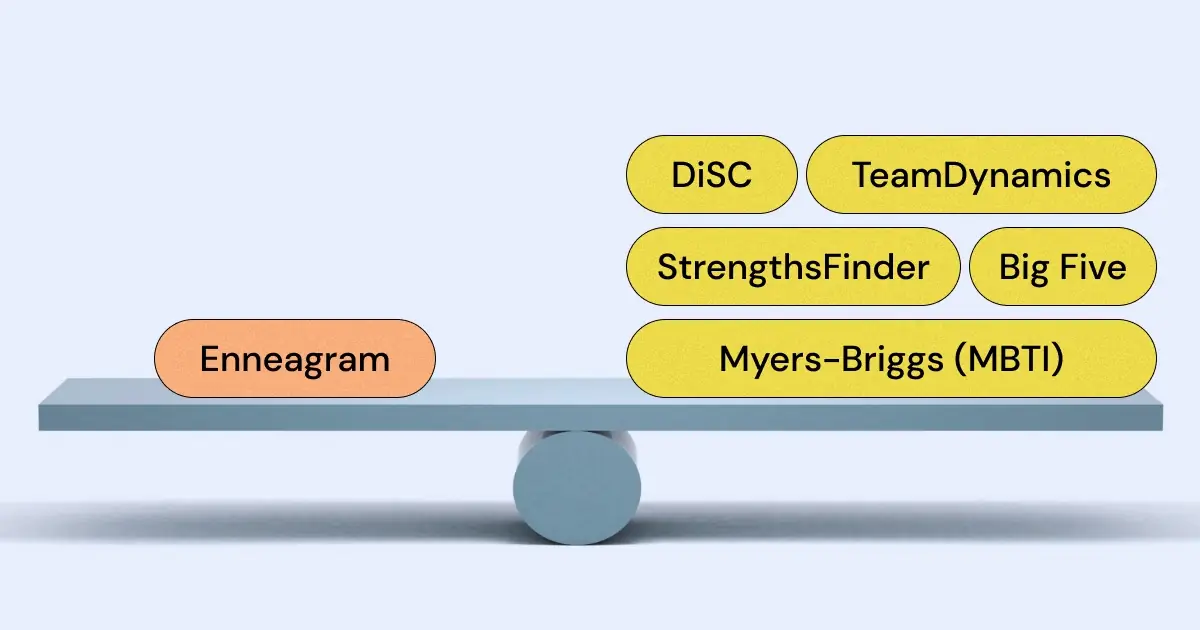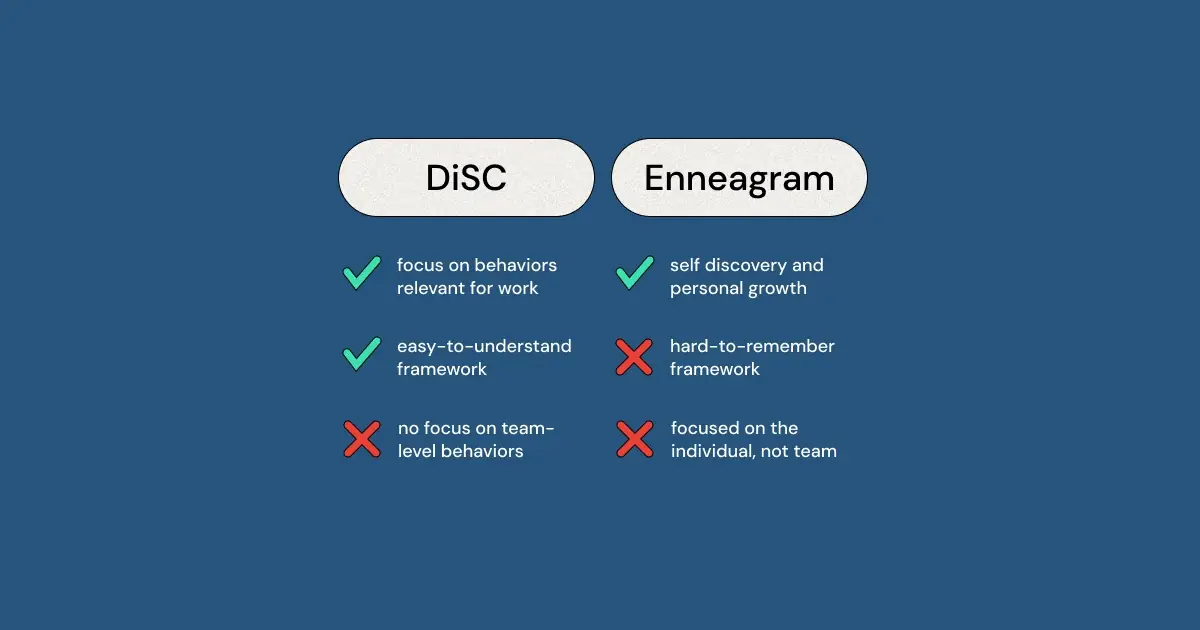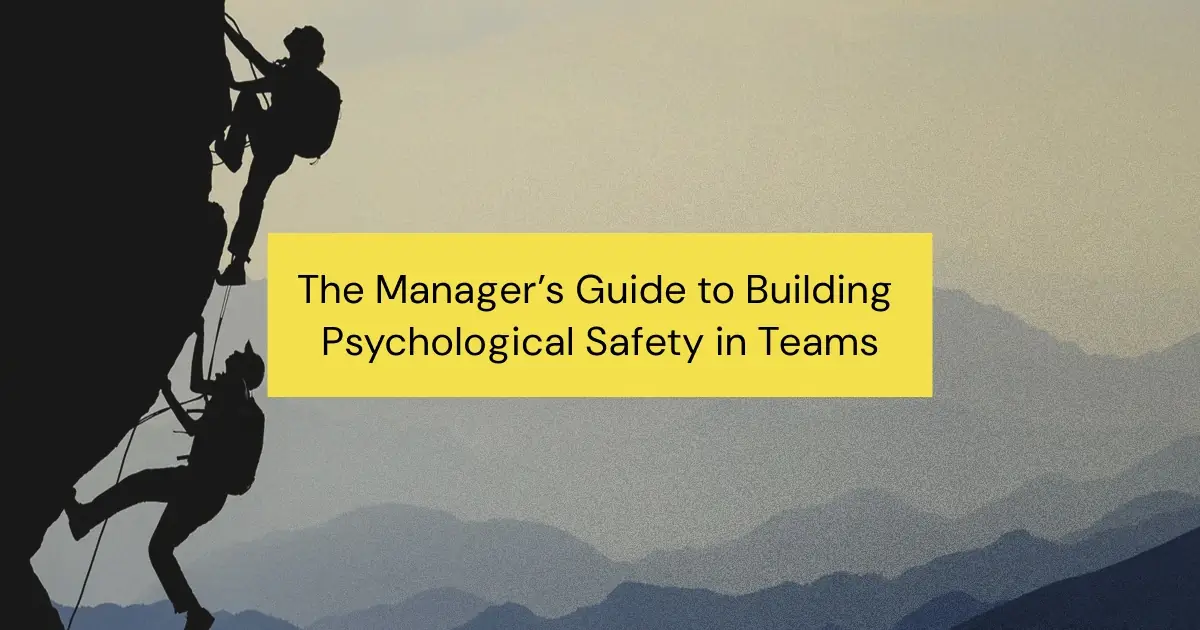Choosing the right personality test can be challenging, especially with so many options available. One of the most popular choices is the Enneagram, which categorizes people into nine distinct types based on their core motivations and fears. However, it’s not the only effective tool out there.
In this blog post, we’ll compare the Enneagram to five other prominent personality assessments: the Myers-Briggs Type Indicator (MBTI), TeamDynamics, StrengthsFinder, the Big Five Personality Traits, and the DiSC Profile. By the end, you’ll have a clearer understanding of how these alternatives can offer unique insights and benefits for both personal growth and professional development.
Alternative #1: Myers-Briggs Type Indicator (MBTI)
The MBTI’s detailed framework of 16 personality types provides a more comprehensive understanding of cognitive styles and behaviors. Its broad applications in both personal and professional settings make MBTI a versatile and practical choice for those seeking to enhance self-awareness and improve team dynamics.
The Myers-Briggs Type Indicator (MBTI) is a personality assessment that classifies individuals into one of 16 distinct personality types. It does this by evaluating preferences across four dichotomies: Introversion (I) vs. Extraversion (E), Sensing (S) vs. Intuition (N), Thinking (T) vs. Feeling (F), and Judging (J) vs. Perceiving (P). Developed by Katharine Cook Briggs and her daughter Isabel Briggs Myers, the MBTI is widely used to help people understand themselves and others better.
What Makes MBTI Special
What sets MBTI apart is its detailed and nuanced approach to personality. By combining four dichotomies, MBTI offers a deep insight into a person’s cognitive style and behavior. This framework helps users gain a comprehensive understanding of their strengths, weaknesses, and preferences. The MBTI is also backed by decades of research and is widely recognized for its reliability and validity in both personal and professional contexts.
Why MBTI May Be Better Than Enneagram
When comparing the MBTI to the Enneagram, several key differences stand out. The Enneagram categorizes individuals into nine types based on their core motivations and fears, offering a more introspective look at personality. While this can be insightful, the MBTI’s 16-type system provides a broader and more detailed spectrum of personality traits. This allows for a more precise and individualized understanding of each person.
Moreover, the MBTI’s focus on cognitive processes can be particularly beneficial in professional settings, where understanding how people perceive information and make decisions is crucial. The MBTI’s structured format makes it easier to apply in various contexts, from team-building exercises to career development programs, offering more practical applications than the Enneagram.
Want to use MBTI for team building? Check out our free MBTI team building workshop download!
Practical Applications of MBTI
The MBTI is widely used in a range of settings. In the workplace, it helps teams improve communication, resolve conflicts, and enhance collaboration by understanding each member’s personality type. HR departments use it for career planning, leadership development, and team-building activities. In educational settings, the MBTI aids students in understanding their learning styles and choosing career paths that align with their personality. Additionally, it is a popular tool for personal growth, helping individuals understand their behavior and improve their relationships.
Alternative #2: TeamDynamics
TeamDynamics provides a comprehensive framework for understanding and improving team interactions. Its focus on team collaboration and practical applications makes it an excellent choice for organizations looking to enhance team performance and cohesion. Whether you’re managing a team or looking to improve workplace dynamics, TeamDynamics stands out as a robust alternative to the Enneagram.
TeamDynamics is a professional personality assessment specifically designed to enhance teamwork and collaboration in professional settings. It identifies teams' work styles and highlights how different personalities can effectively interact within a team. By focusing on team dynamics rather than just individual traits, TeamDynamics provides actionable insights to improve team performance and cohesion.
What Makes TeamDynamics Special
What sets TeamDynamics apart is its unique emphasis on team collaboration. Unlike many personality tests that focus solely on individual traits, TeamDynamics examines how different personalities can work together harmoniously. It provides a detailed analysis of the team's overall working style, as well as each team member’s working preferences, making it a powerful tool for fostering a more productive and cohesive work environment.
Comparing TeamDynamics and Enneagram (and Why TeamDynamics May Be Better)
While the Enneagram offers deep insights into individual motivations and fears, it doesn’t explicitly address team interactions. TeamDynamics fills this gap by focusing on how different personalities can collaborate effectively. This makes it a superior choice for teams looking to improve their dynamics and achieve better results collectively.
Furthermore, TeamDynamics offers practical strategies tailored to each team’s unique composition, helping to address and resolve conflicts, improve communication, and boost overall productivity. In contrast, the Enneagram’s more introspective approach may not provide the same level of actionable guidance for team-based scenarios.
Curious about what TeamDynamics offers? Download a preview of TeamDynamics today!
Real-World Applications of TeamDynamics
TeamDynamics is widely used in professional environments to enhance team performance. It helps teams identify strengths and weaknesses, improve communication, and develop strategies for effective collaboration. Managers use it for team-building exercises, conflict resolution, and optimizing team roles based on individual work styles. Additionally, TeamDynamics is valuable for onboarding new employees, ensuring they fit well with existing team members and contribute positively to the team’s goals.
Consider managing a tech product team. With TeamDynamics, you can identify team practices that need refinement, ensuring the team is not only talented but also well-coordinated. TeamDynamics stands out as an innovative tool designed for modern teams, offering insights beyond what traditional personality tests provide.
{{inline-cta}}
Alternative #3: StrengthsFinder (aka Gallup CliftonStrengths)
StrengthsFinder offers a more practical and strengths-focused approach. Its emphasis on identifying and leveraging individual talents makes it a valuable tool for both personal growth and professional development.
StrengthsFinder, now known as CliftonStrengths, is a tool designed to help individuals identify their top strengths out of 34 possible traits. Developed by Gallup, this assessment focuses on pinpointing what people do best, enabling them to harness their strengths for personal and professional development. Rather than categorizing individuals into personality types, StrengthsFinder highlights unique strengths and talents.
What Makes StrengthsFinder Special
StrengthsFinder stands out due to its positive approach to personality assessment. Instead of focusing on weaknesses or fitting people into predefined types, it emphasizes 34 individual strengths. This strengths-based approach encourages personal growth and self-improvement, fostering a more positive self-concept. The assessment’s focus on actionable strengths helps individuals and teams leverage their unique talents to achieve better results.
Comparison of StrengthsFinder to Enneagram, and Why StrengthsFinder May Be Better
When comparing StrengthsFinder to the Enneagram, several benefits of StrengthsFinder become apparent. The Enneagram delves into core motivations and fears, which can provide deep personal insights but can also be complex and introspective. StrengthsFinder, by contrast, focuses on identifying and utilizing strengths, making it more practical and immediately applicable in everyday situations.
StrengthsFinder’s emphasis on positive traits and actionable insights can be more motivating and empowering than the Enneagram’s exploration of deep-seated motivations and potential negative aspects of personality. For individuals and teams looking to enhance productivity and morale by focusing on what they do best, StrengthsFinder offers a straightforward and encouraging approach.
Want to use StrengthsFinder for team building? Check out our free CliftonStrengths team building workshop download!
Practical Applications of StrengthsFinder
StrengthsFinder is widely used in both personal and professional development. In the workplace, it helps teams understand each member’s strengths, leading to better role alignment and increased productivity. Managers use it for career development, leadership training, and team-building exercises. It’s also valuable for personal growth, enabling individuals to focus on their strengths and develop their potential fully. Educational institutions use it to help students understand their talents and choose suitable career paths.
Alternative #4: Big Five
The Big Five Personality Traits provide a scientifically robust and comprehensive understanding of personality. Its detailed, research-backed approach makes it an excellent choice for those seeking reliable and nuanced insights into human behavior.
The Big Five Personality Traits, also known as the Five-Factor Model, is a widely respected psychological model that assesses personality based on five broad dimensions: Openness, Conscientiousness, Extraversion, Agreeableness, and Neuroticism. These traits provide a comprehensive framework for understanding individual differences in personality and behavior.
Read a longer comparison of Enneagram and Big Five.
What Makes the Big Five Special
The Big Five stands out due to its scientific grounding and empirical support. Developed through decades of research, this model is widely accepted in the psychological community for its robustness and reliability. Each of the five traits is measured on a continuum, offering a detailed and nuanced understanding of personality. This scientific backing ensures that the Big Five provides reliable and valid insights into human behavior.
Big Five vs. Enneagram
When comparing the Big Five to the Enneagram, several key advantages of the Big Five become evident. The Enneagram categorizes individuals into nine distinct types based on core motivations and fears, which can provide valuable insights but often lacks empirical support. The Big Five, on the other hand, is based on extensive psychological research and offers a more detailed and scientifically validated understanding of personality.
Want to use the Five-Factor Model for team building? Check out our free Big Five (OCEAN) download!
The Big Five’s trait-based approach provides a more flexible and comprehensive framework than the Enneagram’s type-based system. This flexibility allows for a more individualized understanding of personality, as it accounts for the full spectrum of traits rather than fitting people into specific categories. For those seeking a research-backed and detailed analysis of personality, the Big Five offers a superior alternative.
Practical Applications of Big Five
The Big Five is widely used in various settings, including research, clinical psychology, and organizational development. In the workplace, it helps in recruitment, team-building, and leadership development by providing insights into employee personality and behavior. It is also used in educational settings to help students understand their learning styles and potential career paths. Additionally, the Big Five is valuable for personal growth, helping individuals understand their strengths and areas for development.
Alternative #5: DISC Assessment
DiSC provides a more practical and accessible framework for understanding and improving interpersonal interactions. Its focus on observable behaviors and clear, actionable strategies make DiSC an excellent choice for enhancing communication and collaboration in professional settings.
The DiSC Assessment is a behavior assessment tool that classifies individuals into four primary personality types: Dominance, Influence, Steadiness, and Conscientiousness. This model helps people understand their behavior and the behavior of others in various settings, particularly in the workplace. By focusing on these four traits, DiSC provides a straightforward and accessible framework for improving communication and teamwork.
What Makes DiSC Special
What makes DiSC unique is its simplicity and focus on observable behaviors. Unlike many personality assessments that delve into complex psychological constructs, DiSC is easy to understand and apply. This makes it particularly useful for quick implementation in professional settings. The clear categorization into four types allows for immediate insights into how individuals can adapt their behavior to interact more effectively with others.
Comparison of DiSC to Enneagram, and Why DiSC May Be Better
Comparing DiSC to the Enneagram reveals distinct advantages of the former. While the Enneagram provides deep insights into underlying motivations and fears, it can be complex and difficult to apply quickly in practical situations. DiSC, on the other hand, focuses on observable behaviors and how they impact interactions, making it more accessible and easier to implement in a team environment.
Additionally, DiSC’s straightforward approach is highly actionable. It offers clear strategies for adapting communication and behavior based on the four personality types. This practicality makes it a better choice for those who need immediate, applicable insights to improve workplace dynamics and enhance team collaboration, unlike the Enneagram’s more introspective and less directly actionable insights.
Want to use DiSC for team building? Check out our free DiSC team communication workshop download!
Practical Applications of DiSC
DiSC is extensively used in various professional settings to improve communication, teamwork, and productivity. It helps teams understand each member’s behavioral style and adapt their communication strategies accordingly. Managers use DiSC for team-building exercises, conflict resolution, and leadership development. It is also valuable in sales and customer service training, helping professionals tailor their approach to different personality types for better outcomes.
Comparing the Top 5 Alternatives to Enneagram
So which of these 5 leading alternatives to Enneagram is right for you and your context? Take a look at this simple comparison table to find out!
| Tool |
Primary Focus |
Best For |
Key Features |
| Myers-Briggs Type Indicator (MBTI) |
Cognitive Preferences |
Understanding cognitive styles for effective communication and decision-making |
Provides insights into 16 personality types, focusing on cognitive processing and decision-making preferences; ideal for fostering better interpersonal dynamics. |
| TeamDynamics |
Team Dynamics and Cohesion |
Building cohesive and high-performing teams in professional environments |
Focuses on collective team behaviors and communication patterns; provides actionable strategies to improve team cohesion and resolve friction points for optimal performance. |
| StrengthsFinder (Gallup CliftonStrengths) |
Individual Strengths |
Identifying and leveraging strengths for personal and team productivity |
Highlights top talents from a set of 34 strengths, encouraging positive development and role alignment within teams; actionable insights make it ideal for motivating team members by focusing on what they do best. |
| Big Five Personality Traits (OCEAN) |
Research-Based Personality Traits |
Providing a reliable and research-backed understanding of personality for comprehensive insights |
Empirical model based on five major personality traits: Openness, Conscientiousness, Extraversion, Agreeableness, and Neuroticism; ideal for a detailed, trait-based view of personality. |
| DiSC Assessment |
Observable Behavior |
Improving communication and teamwork through behavior analysis |
Classifies individuals into four primary behavioral types (Dominance, Influence, Steadiness, Conscientiousness); straightforward and practical for improving workplace communication and teamwork. |
Conclusion
While the Enneagram offers valuable insights into individual motivations and fears, exploring alternatives like the Big Five, StrengthsFinder, TeamDynamics, MBTI, and DiSC reveals distinct advantages for different needs. The Big Five stands out for its scientific rigor and detailed trait analysis, StrengthsFinder focuses on harnessing individual strengths, MBTI provides a nuanced understanding of cognitive preferences, and DiSC excels in improving communication and teamwork through behavior-based insights.
Looking to use the Enneagram for team building? Check out our free downloadable Enneagram team building workshop!
However, when it comes to optimizing team performance and collaboration, TeamDynamics emerges as the superior choice. Unlike the other assessments, which often focus on individual traits, TeamDynamics is specifically designed to enhance team interactions and dynamics. Its comprehensive analysis of work styles and communication preferences offers actionable strategies to improve team cohesion and productivity. Whether you’re managing a team or seeking to foster a more collaborative work environment, TeamDynamics provides the practical and tailored insights needed to achieve better results. For most professional settings, TeamDynamics stands out as the most effective tool for building stronger, more effective teams. Try TeamDynamics today and see how it can unlock your team’s full potential.




.png)










































